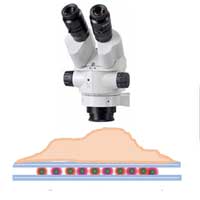 Inductors are set to join other electronic components in being miniaturized thanks to a quantum effect.
Inductors are set to join other electronic components in being miniaturized thanks to a quantum effect.
Thursday, February 4, 2021
Inductance based on a quantum effect has the potential to miniaturize inductors
 Inductors are set to join other electronic components in being miniaturized thanks to a quantum effect.
Inductors are set to join other electronic components in being miniaturized thanks to a quantum effect.
An optical coating like no other
 A 'FROC' can both transmit and reflect the same color simultaneously, a breakthrough in optical coating.
A 'FROC' can both transmit and reflect the same color simultaneously, a breakthrough in optical coating.
New nanoimaging technique allows comprehensive testing of 2D materials
 A new nanoimaging technique that will allow researchers to test and identify novel 2D materials in a comprehensive way at the nanoscale for the first time.
A new nanoimaging technique that will allow researchers to test and identify novel 2D materials in a comprehensive way at the nanoscale for the first time.
Quasicrystal-clear: Material reveals unique shifting surface structure under microscope
 Scientists reveal peculiar surface structure in materials resembling quasicrystals with interesting implications for its magnetic properties.
Scientists reveal peculiar surface structure in materials resembling quasicrystals with interesting implications for its magnetic properties.
Polymer-derived carbon as metal-free, 'green' alternative to catalysts and nanocarbons
 Scientists have succeeded in synthesizing macroscopic carbons that are similar in handling to common technical catalysts.
Scientists have succeeded in synthesizing macroscopic carbons that are similar in handling to common technical catalysts.
How metal atoms can arrange themselves on an insulator
 In order to produce tiny electronic memories or sensors in future, it is essential to be able to arrange individual metal atoms on an insulating layer. Scientists have now demonstrated that this is possible at room temperature.
In order to produce tiny electronic memories or sensors in future, it is essential to be able to arrange individual metal atoms on an insulating layer. Scientists have now demonstrated that this is possible at room temperature.
Benchmarking transistors built from ultra-thin 2D materials
 Two-dimensional materials can be used to create smaller, high-performance transistors traditionally made of silicon.
Two-dimensional materials can be used to create smaller, high-performance transistors traditionally made of silicon.
Graphene quantum dots achieve high-resolution imaging
 With the help of these quantum dots, researchers can use super-resolution technology to break the optical diffraction limit and fill the gap between the electron microscope (about 1 nm) and the ordinary visible optical microscope (200-250 nm).
With the help of these quantum dots, researchers can use super-resolution technology to break the optical diffraction limit and fill the gap between the electron microscope (about 1 nm) and the ordinary visible optical microscope (200-250 nm).
Molecules bend for organic electronics
 Scientists have created a new type of conducting polymer containing both linear and ring elements. The new polymers have very different electronic properties than scientists would expect if the polymers simply added the contributions from each linear and ring-shaped component.
Scientists have created a new type of conducting polymer containing both linear and ring elements. The new polymers have very different electronic properties than scientists would expect if the polymers simply added the contributions from each linear and ring-shaped component.
Fluorescent metal organic frameworks go dark to detect explosives
 Researchers have shown how the structure of the MOF, and its interactions with the guest molecules, can produce a signal. With this understanding, researchers can design MOFs to be sensor materials for many important applications. These findings could lead to simpler ways to detect chemicals, including explosives.
Researchers have shown how the structure of the MOF, and its interactions with the guest molecules, can produce a signal. With this understanding, researchers can design MOFs to be sensor materials for many important applications. These findings could lead to simpler ways to detect chemicals, including explosives.
Vibrating nanodroplets may invade a tumor
 Sending tiny droplets to a tumor and having them vaporized using focused ultrasound: it could be a new way of tracing a tumor or deliver drugs locally.
Sending tiny droplets to a tumor and having them vaporized using focused ultrasound: it could be a new way of tracing a tumor or deliver drugs locally.
Subscribe to:
Comments (Atom)
